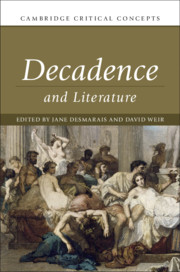Part III - Applications
Published online by Cambridge University Press: 12 August 2019
Summary
From its emergence in the mid-nineteenth century, decadence has been, fundamentally, a socio-cultural response to urban modernity. Indeed, decadence is all but unthinkable outside the borders of the modern metropolis. Hence this chapter treats literature less as a literary critic would and more as an urbanist thinker might. An urbanist reading of a decadent text must perforce pay attention not only to urban geography, including the plan of the city in which the work is set, its dominant architectural styles, socio-economic differences in neighborhoods, and so on, but also to the cultural, social, and psychological meanings that the urban setting produces in a particular decadent text. In this essay, the urbanist approach is brought to bear on three novels whose urban geography is especially significant to their respective narratives: Gabriele D’Annunzio’s Il Piacere [Pleasure] (1889), Oscar Wilde’s The Picture of Dorian Gray (1891), and Thomas Mann’s Der Tod in Venedig [Death in Venice] (1912). These three works illustrate, respectively, the special relationship of the urban scene to cultural, social, and psychological issues germane to the decadent narrative of each novel.
Keywords
- Type
- Chapter
- Information
- Decadence and Literature , pp. 265 - 399Publisher: Cambridge University PressPrint publication year: 2019

